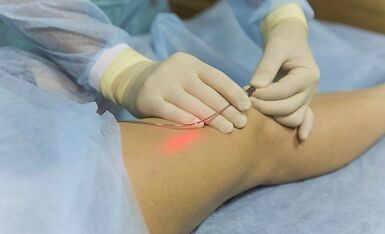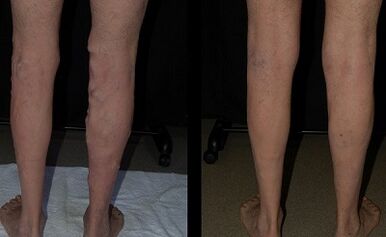
Get a fleet direction to get into treating with a laser with a laser.There is no need to hospitalize and extend the patient, so the laser treatment of varicose veins is carried out on the outpatient basis.
The blow occurs regardless of the patient's caliber.It may be a small vascular mesh or a large nodal formation.The next day, the patient can return to a completely ordinary lifestyle with insignificant restrictions.
Before performing the procedure, a clear definition of the affected zone is a clear definition of the borders using the ultrasound research.It is extremely important to determine the existence of the tributars.
Endovasal (or withdrawal) laser oxyphemoglobin and moves related to the principle of selective absorption of hemoglobin.The patient is in a horizontal position.The surgeon first processes the location of the puncture, making a microscopic in size and presents a catheter to the sick vessel with a flexible pipe with light light.The walls of the ship were alloy and brewed with the help of heating.As a result, blood stops flow over Vienna, turns off overall turnover, and then it turns out incompatible fibrous litter.
After the catheter is removed, a small sterile dressing is applied to the puncture.After intervention for the patient, the varicose, which can create necessary compression, wears a special underwear for the veins.
Advantages of the method
- Laser treatment gives a very effective and real result.
- After that, rehabilitation is hours.
- The operation is not more than one hour.
- During manipulation, the skin, fabrics and other ships are not usually broken.
- Aesthetic preference, there is no smallest trace in the place of the catheter.
- The technique is suitable for people with low pain because it is less painless.
- It is possible to treat different limbs in several ships and in one session.
- For example, the ability to expose combined using sclerotherapy.
- As the use of local anesthesia, as general anesthesia, guarantees the minimum number of negative intolerance.
To determine the need and possibility of such an operation, you need to do an ultrasound scanning first and duplex.
To whom this treatment is shown
At the moment, there are many ways to get rid of radical from varicose veins.These are sclerotherapy, flekectomy, radio frequency effects.

If the varicose veins are removed by a laser:
- The vascular extensions lasted up to 10 mm;
- A small number of numbers affected by the disease are determined;
- The vascular walk, without bending, there is a bending for laser treatment, you can use two LEDs with a catheter, the confidence of heavy vein is complete for surgery;
- It is impossible to implement the procedure, such as complications, such as the formation of damage to trophical Ülkers.
Many specialists recommend laser treatment as a modern alternative to full surgery.Moreover, with the participation of modern equipment and doctors, the behavior of such non-unused procedures allows you to talk about high security for the patient.
Sometimes you need to carry several treatments sessions with severe and very pathological.For each patient, you need more than them, only doctors determine depending on the term and extent of the disease of the disease.An important factor in resolving such an issue is a person's age and general condition.Sometimes the skin's light redness can occur after the intervention, which can pass very quickly and does not require additional exposure.
Wall
After the operation, the patient should walk in pedestrian, slowly, but not less than 40 minutes.Then you need to wear a knitted knitting and dress up for about five days.
After the first few days, it is not recommended that the sunset, physical exercise, to take a hot bath.
Counter-contrastingations
Despite enough security, there is certain reflection in therapy with the help of a laser:
- Pregnancy and breastfeeding.
- Use of glucolicoids and agents that help photographing photography in the treatment.
- Tarieged processes.
- Severe chronic diseases with the development of kidneys, liver and lung deficiency.
- Diabetes of any form.
- Thrombophlebitis.


















